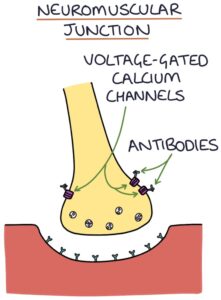Lambert-Eaton myasthenic syndrome is an autoimmune condition affecting the neuromuscular junction, similar to myasthenia gravis. The symptoms tend to be more insidious and less pronounced than myasthenia gravis.
In most cases, it is a paraneoplastic syndrome occurring alongside small-cell lung cancer (SCLC). It can occur as a primary autoimmune disorder without the presence of SCLC.
Pathophysiology
Lambert-Eaton myasthenic syndrome results from antibodies against voltage-gated calcium channels. These antibodies may be produced in response to small-cell lung cancer (SCLC) cells that express voltage-gated calcium channels. They target and damage voltage-gated calcium channels in the presynaptic membrane of the neuromuscular junction.

Voltage-gated calcium channels are responsible for assisting in the release of acetylcholine into the synapse of the neuromuscular junction. Acetylcholine travels across the synapse and attaches to receptors on the postsynaptic membrane, simulating muscle contraction. When the voltage-gated calcium channels are destroyed, less acetylcholine is released into the synapse, resulting in a weaker signal and reduced muscle contraction.
Presentation
The key presenting features are:
- Proximal muscle weakness, causing difficulty climbing stairs, standing from a seat or raising the arms overhead
- Autonomic dysfunction, causing dry mouth, blurred vision, impotence and dizziness
- Reduced or absent tendon reflexes
Signs and symptoms improve after periods of muscle contraction, which is the reverse of what is seen in myasthenia gravis. Reflexes may be absent in a rested patient but be present when testing immediately after the patient maximally contracts the associated muscles. Equally, muscle strength may improve after use.
Management
Excluding underlying malignancy (e.g., small-cell lung cancer) is essential.
Amifampridine works by blocking voltage-gated potassium channels in the presynaptic membrane, which in turn prolongs the depolarisation of the cell membrane and assists calcium channels in carrying out their action.
Other options include:
- Pyridostigmine (cholinesterase inhibitor)
- Immunosuppressants (e.g., prednisolone or azathioprine)
- IV immunoglobulins
- Plasmapheresis
Last updated October 2023
Now, head over to members.zerotofinals.com and test your knowledge of this content. Testing yourself helps identify what you missed and strengthens your understanding and retention.

